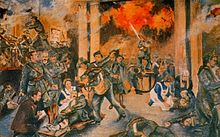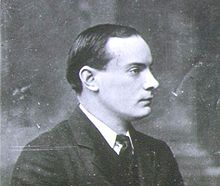Republicanism (Ireland)

As republicanism ( English republicanism , irish poblachtachas ) is in Ireland usually a radicalized flow of modern Irish nationalism referred. Important representatives of this political direction today are the parties Fianna Fáil and Sinn Féin , although the former has always only supported its non-violent form. The countercurrent to republicanism is unionism , which is particularly widespread in Northern Ireland .
In the Northern Ireland conflict, the Republicans are striving to abolish the territorial status quo (the division of the island of Ireland into Northern Ireland and the Republic of Ireland ) and thus the unification of the entire island of Ireland under an Irish nation state ( English : United Ireland ) (i.e. in fact Northern Ireland's accession to Republic of Ireland).
development
Theobald Wolfe Tone (1763–1798) introduced the concept of republicanism into the Irish discussion and used it to describe a more radical form of independence from England, which should also include economic and cultural independence. He was inspired by the French Revolution .
But it was not until the 19th century that the Young Irelanders movement formulated the three fundamental axioms of Irish republicanism: complete independence from England, unrestricted right to enforce the sovereignty of the Irish people by all means, and preservation of the national heritage. Three names are associated with this: John Mitchel (1815–1875) called for the creation of a republic that should be completely independent of England politically and economically; James Fintan Lalor (1808–1849) emphasized popular sovereignty and the importance of the land question; Thomas Davis (1814–1845) argued for the preservation of Irish origin; He made pride in the Gaelic past, the promotion of the Irish language, literature and music and traditional sports an integral part of Irish nationalism.
Patrick Pearse (1879–1916) understood these three men and Wolfe Tone as the New Testament evangelists of Irish nationalism . For Pearse, the struggle for independence was sacred, and this quality carried over to those who waged it: “Splendid and holy causes are served by men who are themselves splendid and holy.” Pearse is one of the most important theoreticians of the republican movement to this day, and the official Republic of Ireland , as author of the 1916 proclamation of the Republic of Ireland, sees him as one of the fathers of the nation.
Republicanism as an organized political movement has existed in Ireland since 1858, when James Stephens founded the Irish Republican Brotherhood (IRB) in Dublin , at the same time and coordinated with the founding of the Fenians by James O'Mahony in New York.
Until its dissolution in 1924, the IRB secret society played an important role in the Irish independence movement. The planning and direction of the Easter Rising of 1916 were in the hands of members of the IRB, which, through a targeted strategy of infiltration into mass organizations such as the Irish Volunteers and Sinn Féin, exerted an influence that exceeded its proportional share of members. While the influence of the IRB quickly vanished after the Easter Rising, the Sinn Féin, founded by Arthur Griffith in 1905, went through a transformation process after the uprising, also through targeted infiltration, and became the new, politically leading center of the independence movement; On the military side, the Irish Republican Army (IRA) emerged from the collaboration between volunteers and the Irish Citizen Army during the uprising . The Easter Rising can therefore be seen as the birth of republicanism as a mass movement in Ireland, although it failed completely due to poor planning and the conspirators had to give up after a few days. During and immediately after the uprising, most of the local Irish were also against the rioters, as around 400 civilians died and central Dublin was completely destroyed. The subsequent shootings of the leaders, the internment of thousands of innocents and the planned introduction of compulsory military service in Ireland resulted in a complete change of mood among the Irish population.
In the general election of 1918, Sinn Féin won almost 70% of the Irish seats. As announced during the election campaign, however, the MPs did not take their seats in the British House of Commons, but instead constituted themselves in 1919 as Dáil Éireann and, as in the Easter Rising, proclaimed an independent Irish republic. This was the first Irish Parliament since 1801. The British Parliament immediately declared the Dáil illegal. The result was the Irish War of Independence from 1919 to 1921, which was a kind of guerrilla war by the IRA. After the fighting ended, the south of the island of Ireland became a quasi-independent dominion in the Commonwealth in 1922 . However, some parts of the IRA and Sinn Féins rejected the Anglo-Irish Treaty because Ireland did not become a fully independent republic, Irish parliamentarians of the Dáil had to take an oath on the British monarch and Ireland was divided. Therefore they continued their fighting in the south of Ireland. This led to the split in the movement and the fierce Irish Civil War (1922–1923) in the new Free State of Ireland . Even after the defeat in the civil war, the remnants of the IRA continued to carry out attacks in the Free State until the late 1930s in order to achieve their goal of a completely independent republic. It was not until the late 1930s that the separation of Northern Ireland from the United Kingdom and the reunification of Ireland into an independent republic came to the fore as the main political goal within Irish republicanism. This happened because the then Irish ruling party Fianna Fiál, which advocates moderate Irish republicanism, converted the Free State into the de facto Republic of Éire after constitutional changes. In 1948 the last ties to Great Britain were cut and Éire was officially declared the Republic of Ireland . Now the IRA renounced attacks in the south and directed all its energy against Northern Ireland and Great Britain.
literature
- Boyce, D. George .: Nationalism in Ireland. 3rd, revised edition. Taylor & Francis, Dublin 2003, ISBN 978-0-203-43384-3 .
- Busch, Nicolaus: The extra-parliamentary, republican movement in Ireland 1925–1945. Hamburg 1992, ISBN 978-3-640-47873-6 .
- Cronin, Sean: Irish Nationalism. A History of its Roots and Ideology. 1st edition. Continuum, Dublin 1981, ISBN 978-0-8264-0062-8 .
- Edwards, Ruth Dudley: Patrick Pearse - The Triumph of Failure. Gollancz, London 1977, ISBN 0-575-02153-5 .
- Kee, Robert: The Green Flag: A History of Irish Nationalism. Weidenfeld and Nicolson, London 1972, ISBN 0-297-17987-X .
- O'Broin, Leon: Revolutionary Underground. The Story of the Irish Republican Brotherhood 1858-1924. Dublin 1976, ISBN 0-297-17987-X .
